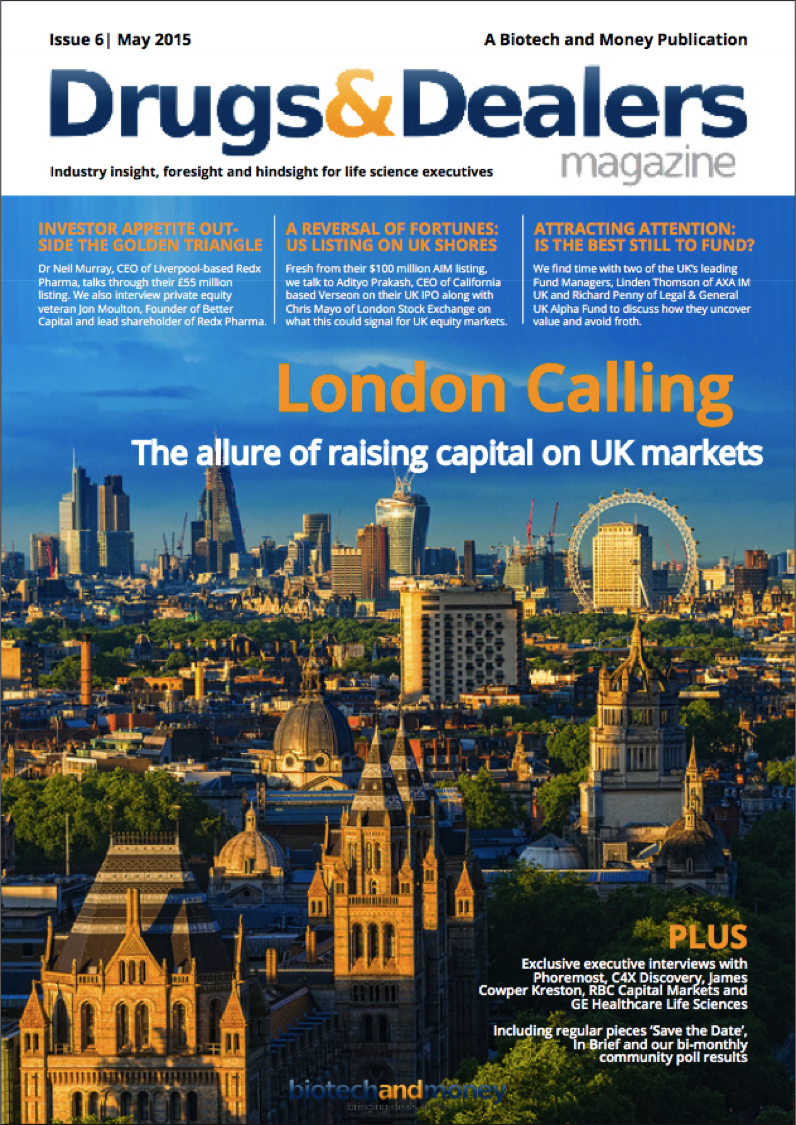How to make a £3bn life science company
- How Jim Phillips, CEO, Midatech Pharma plans to create a £3bn healthcare company: the key success factors
- Why Midatech’s IPO on AIM last year was successful: key lessons
- What needs to happen for investment in the biotech industry in the UK to grow
- How to encourage generalist investors to engage more in the sector
Midatech Pharma raised £32m in its AIM listing at the end of last year, giving the company a market capitalisation of £74.2m. Chief executive, Jim Phillips has big ambitions for the life sciences company. To be specific, he intends to turn it into a £3bn company. How is he going to do that?
I caught up with him to ask him that very question, and dig a little deeper into his story and lessons from his IPO, the challenges he is currently facing and his ideas for how the biotech industry can attract more investment.
Interview with Jim Philips, CEO, Midatech Pharma
Terry O’Dwyer (TO): Can I start the interview by asking you to tell me your company elevator pitch. What are your products and technologies and what makes you unique?
Jim Phillips (JP): Midatech Pharma is working towards building a speciality pharmaceutical business with multiple products, by developing our platform technologies. Our business model consists of three pillars. Firstly, the development and commercialisation of our own products, particularly for rare cancers. Secondly, the development and commercialisation of partner-supported and licensed products, particularly in diabetes and neuroscience/ophthalmology, and thirdly acquisition of later stage strategic and complementary opportunities. We are a company that is looking to acquire other businesses and to commercialise our own products to drive revenue growth rather than looking to become successful by licencing products.
TO: What are your key focus areas at the moment?
JP: Our pipeline is divided into three therapeutic areas, endocrinology, cancer and neuroscience/ophthalmology. We have a joint venture in diabetes with a US company and our own programmes in rare cancers which we will take forward to commercialisation ourselves. Additionally, we have some rapidly advancing programmes in the treatment of eye diseases.
TO: I understand you are currently working on about 15 projects. Out of those projects, are there any impending or recent product launches that you’re particularly excited about?
JP: I’m excited by all of our projects, particularly because of their huge market potential. We estimate that any one of our products could deliver revenues of hundreds of millions. The projects in our pipeline that are most advanced and are most likely to generate those revenues in the short term, are both Transbuccal Insulin, which is in phase 2 with very exciting phase 1 data, and our relatively short term-to-market super generic, which is a form of Sandostatin LAR with the potential for far more advantageous product characteristics. More recently, we’re fast-tracking a programme for uveitis where we’ve had stunning pre-clinical results with an existing drug being reformulated using our technologies. Those three are the lead programmes at this point in time. Following those is our glioblastoma programme, which is probably the most exciting in terms of saving people’s lives in the future.
TO: Thanks for that overview. Let’s talk now about your IPO last December. Can you tell me what the reasons were behind the IPO and, now that it is complete, how satisfied you are with the outcome?
There are three pillars to our corporate strategy. First, there are partnerships and partnership based revenues. Secondly, developing our own products to commercialisation and then thirdly, our M&A strategy to deliver revenue growth.
JP: We raised money in the public markets to do several things including funding the clinical development of the pipeline, covering clinical trials, developing our neuroscience and sustained release technology, for working capital and of course to fund our M&A strategy. There are three pillars to our corporate strategy. First, there are partnerships and partnership based revenues. Secondly, developing our own products to commercialisation and then thirdly, our M&A strategy to deliver revenue growth. Whilst we could develop partnerships and commercialise our own products with private funding, M&A requires an additional injection of equity.
We carefully considered the geography of our listing and after spending some time in the US, we decided that we should start out by being a London-listed and internationally-focused company; where our local investors would understand us better and it would be advantageous to complete our IPO in the UK.
The IPO was very well-executed in a difficult market. We got most of the book covered before the roadshow which is why we went out with a high level of confidence. The book was oversubscribed and we were able to cut back allocations and to increase the amount we raised from the original target amount. All of that has led to a successful aftermarket in the last 3 months in which our share price has been on a steady upward trend, even though we’ve had some shareholders sell out in the last three months.
TO: So overall an extremely positive and satisfying outcome?
JP: So far, incredibly good, yes.
TO: This isn’t your first IPO; you’ve done it before. If you reflect on your experiences, are there any lessons you may have learnt that you could share with some life science companies that are currently thinking about going public?
For traditional biotech companies who are looking to go public, it is important to have a late stage pipeline. This way you can create a more de-risked company for your investors.
JP: As a non-executive director, I was also involved in the flotation of a Finnish biotech company last year. The public markets, especially in London, are very choosy, so companies that are thinking of going public have to be very clear about differentiating their business. The market doesn’t really value companies properly with only two or three novel products. The successful IPOs last year, such as Horizon Discovery, were the ones that had revenue from platforms, enabling lots of shots on goal. The traditional biotech is less attractive for public investors because of its less de-risked nature. That’s what we also found with the Finnish biotech IPO and we also the experience of a difficult aftermarket.
For traditional biotech companies who are looking to go public, it is important to have a late stage pipeline. This way you can create a more de-risked company for your investors. Investors want to hear and see how companies are going to grow revenue and become commercially successful businesses in the future.
TO: What do you think it was about your own particular story with Midatech that investors found compelling?
We have a revenue story and we’re also able to demonstrate how we’re going to execute our strategy to become what we hope will be a multi £bn valued British example of an international success story.
JP: I believe that it’s mainly the 3 parts to our story. We have revenues that are growing today, and some of those revenues will turn into licencing deals in the short-term. We also have the bandwidth and the ability to get products to market fast. We can also launch our own products and therefore get a huge upside from the potential of each of those products for developing our own commercial infrastructure. The other part they liked was that we would use acquisitions as and when appropriate to accelerate our revenue growth. So we have a revenue story and we’re also able to demonstrate how we’re going to execute our strategy to become what we hope will be a multi £bn valued British example of an international success story.
TO: I’ve heard you before say your ambition is to make Midatech a £3bn company. What do you think are the key success factors necessary to achieve this?
JP: The first key to success will be the delivery of a couple of licencing deals and products into the market through partnerships we already have. This is relatively near-term and will drive us to profitability quickly. Secondly, we want to launch a new product every 18 months to 2 years throughout the 2020s from our own stable, selecting the best products from the ones we have in the pipeline and fast-tracking those into the market. Thirdly, we aim to build our valuation through strategic acquisitions.
TO: What’s going to stand in your way and prevent you from achieving that?
JP: As with any clinical programme, there is a risk in execution. Based on our technology we are developing two platforms, one which is a very low risk and the other which is a moderate risk as we have yet to launch the first product in the market based on that technology. Each program carries a level of risk and that’s why our focus has been on the rare cancers because these are conditions in which, if the products work as we intend them to as guided missiles to the tumour, they present fewer potential issues than, for example, chronic therapy.
TO: As a CEO, what do you think you can do to help mitigate that risk?
JP: The key part of my role is to conduct the orchestra and build a great team around me. With Midatech, that is what we have already done and it’s been one of my jobs in the past two years to reinvigorate and bring in great talent to the management team. We have a phenomenal team now.
Beyond that, we need to be able to quickly stop programs that are not working, which I’m confident we’re set up to do. We need to also continually look for other things that will help us de-risk the company, which is where our strategy of acquisitions comes into play as a way of fast-tracking us to producing significant revenues.
TO: Are there any acquisitions or potential acquisitions on the horizon that you could talk about?
JP: It’s our responsibility to always look for good investment opportunities but clearly we cannot comment on any acquisitions at this stage.
TO: Of course. Let’s turn now to the industry as a whole. If we look at the life sciences industry in the UK in particular, what do you think needs to happen for investment in this sector to grow?
We need success to drive more interest in the private funding mechanisms and then to allow us to develop a pool of specialist investors in the future
JP: We need more successes and we need to create more of a virtuous circle for investors. The European market is starved of venture capital compared to the US and even in places like Singapore. There have been some good new funds raised recently but the risk capital available for private companies in Europe is far too low and it’s only successes that will allow that pool of risk capital to grow. Unfortunately, the 1990s model of biotechnology didn’t create a self-replenishing pool of risk capital because there were too many failures.
We also need to develop a pool of public specialist investors both in Europe and in London. Woodford has just launched his new biotech fund which is private and public and that’s a good step in the right direction but we don’t yet have the Framlington Biotech-type funds that there are in the US or the pool of specialist investors that will allow companies to raise capital publically without going to generalists who don’t necessarily understand the sector. These two things really are interlinked so we need success to drive more interest in the private funding mechanisms and then to allow us to develop a pool of specialist investors in the future. Many of the investment banking teams in healthcare were disbanded after 2008/9 and there’s even a diminished pool of investment banking capability in Europe as well.
TO: Do you think that success is being achieved at the moment to the level that is required? Some people say that floats of Circassia and Horizon Discovery, and probably also Midatech, might be the beginning of a major shift. What’s your view on that?
JP: Circassia is a bit of a different story, so I’m not really going to comment on its place because it is more of a biotech player in a specific sector. Companies like Horizon and Midatech, and also Abzena to a certain extent, are a different story where revenue growth is important, where there’s M&A involved and a drive towards developing and sustaining a fast growth company. That’s not the be all and end all because it’s only one part of the sector but it is a philosophy. It’s a strategy that Abzena, Horizon and Midatech have all developed towards similar paths. Our differentiator is that we want to commercialise pipeline products whereas the other two companies don’t. Because they are somewhat de-risked and focused on revenue they have the potential to drive a new interest in the sector through their success because they all have much lower risk profiles to investors than the old biotechs did. It’s about execution. Each company carries execution risk and none of us want to miss our forecasts or our analysts’ forecasts but they are also a much more positive story that generalist investors can understand and buy into because it’s very difficult to value traditional biotech stocks.
TO: A number of people complain that there is a lack of generalist investors keen on the biotech sector. What do you think it is that CEOs such as yourself and others can do to help educate and encourage generalist investors to engage more in the sector and get involved?
JP: It’s all about communication and good investor relations. My personal view is that the investor relations world in London is much sleepier than it is in many other places, especially in the US, so if we can boost that side of our businesses and get our advisors to help us in doing that, it would help the sector and help generalist investors to understand the opportunities and develop more interest in the sector.
TO: Finally, are you optimistic about the future of the sector in Europe and, if so, why and, if not, why not?
JP: Yes. I am optimistic about the future of the sector as a whole. However, as in any sector where companies work on innovation, there’s always going to be fall-out along the way and that is why you have to try to back the winners, yet not everything is going to succeed. There have been reasonable inflows of money into the sector in the last 18 months. We raised about $770m in public IPOs last year in Europe but that’s poor compared with the US which raised an estimated $5.5bn. The markets are definitely in a better place; the number of secondary investments in Europe last year was over $1.5bn and that shows that where companies start to succeed there is appetite to continue to invest and allow them to grow. That’s very good news for the community as well, with positive new funds being raised within the European sector.
This article was published in our March Drugs & Dealers Magazine, along with several other exclusive CEO interviews and features. Become a Member for free to access it.






Leave a comment